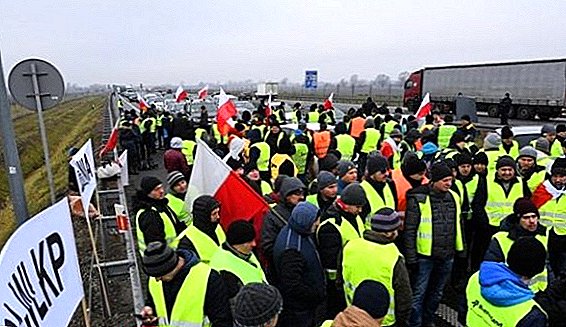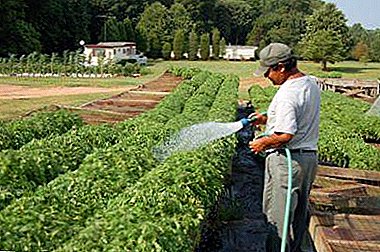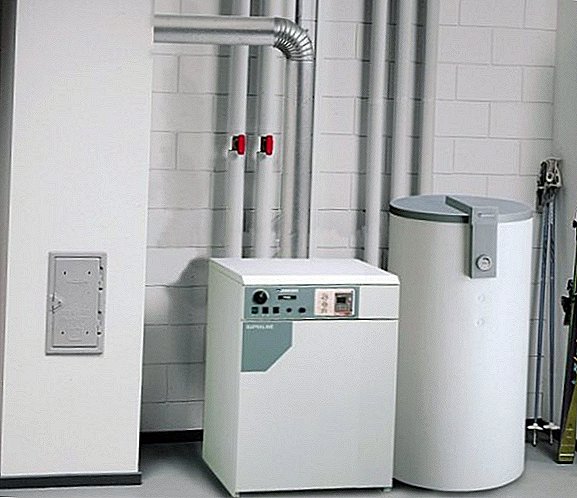 For heating modern private homes, special heating boilers are often used, which distribute heat to all the rooms in the house. On the market you can find a variety of equipment, the main difference between which will be used by them fuel: gas, electricity, liquid fuel, pellets and some other alternative types. We will understand the features of the choice of heating boilers more closely.
For heating modern private homes, special heating boilers are often used, which distribute heat to all the rooms in the house. On the market you can find a variety of equipment, the main difference between which will be used by them fuel: gas, electricity, liquid fuel, pellets and some other alternative types. We will understand the features of the choice of heating boilers more closely.
What to look for when choosing a boiler
When buying a boiler for home heating, you need to take into account a number of nuances.
At a minimum, review the following steps:
- if you do not have the ability to connect electricity to such equipment, then you will have to consider only stand-alone options with an atmospheric burner;
- Be sure to check the possibility of additional installation of a stabilizer or UPS, especially if the house often has a power outage;
- decide your specific boiler requirements: you only need it for heating (economical single-circuit models are suitable) or also for water heating (double-circuit boilers with two or one heat exchanger are used);
- find out whether the chosen option corresponds to the area and the remaining characteristics of the house (the required power of the equipment directly depends on this;
- estimate the cost of the boiler, because the more powerful such equipment is, the more expensive it will be, although much depends on the manufacturer (brand);
- choose if not very well-promoted brands, then at least fairly well-known, which you can already find reviews, service centers, or at least buy the necessary spare parts (among the proven brands you can mention Ariston, Vaillant, Ferroli, Buderus);
- Learn about the material of the heat exchanger: the most durable and durable - copper options, but because of their high cost, many buyers prefer steel structures, and cast-iron varieties, although they have good heat dissipation, but impractical because of the large weight;
- decide on the type of boiler: floor-standing (a good option for houses with an area of 250-300 m²) or wall-mounted (suitable for small country houses or cottages);
- pay attention to the type of combustion chamber: open suck out air from the room and require the arrangement of a standard chimney, while closed ones can be installed in any room and need only a horizontal chimney with an exit outside the house;
- pay attention to the performance characteristics of the selected model, because it is important that it is not only effective, but also safe and multifunctional (learn about the power control system, the presence of a timer that allows you to set the time to turn on the boiler and thermostat that automatically stops it when it overheats).
In order not to be mistaken in your choice, before going to the store it is better to get advice from a qualified specialist.
Did you know? The first boilers appeared even a few centuries BC. (I testify to this archaeological excavations in India and even in Ukraine), but at that time they were hardly used for heating houses, moreover, scientists consider them to be tools for sacrifices.
How to calculate the power of the required boiler
Accurately calculate the required power of the boiler for your home can only heat engineer who knows about all the nuances of this process. Nevertheless, it is still possible to get an approximate figure, because if you take into account that 1 kW of equipment capacity is able to heat 10 m² of a well-insulated room, then it is clear that a house of 100 m² will need about 10 kW.  However, this is a very simplified version of the calculations, because you always need to take into account additional conditions: the height of the ceilings in the rooms, the size of the windows, the need to heat the summer kitchen, the glass veranda or simply insufficiently insulated rooms with thin walls.
However, this is a very simplified version of the calculations, because you always need to take into account additional conditions: the height of the ceilings in the rooms, the size of the windows, the need to heat the summer kitchen, the glass veranda or simply insufficiently insulated rooms with thin walls.
Of course, in all these cases, the boiler must consume more energy, which means that it must have greater power characteristics.
We advise you to read about how to put the socket and the switch, how to remove the paint from the walls, whitewash from the ceiling, how to glue the wallpaper, how to whiten the ceiling in your house.
If, in addition to the premises, the boiler heats up the water, then the value of the calculated characteristics should be automatically doubled. Also it is necessary to take into account the presence of warm floors in the house, which require additional energy and an increase in boiler power by at least 20%.
Video: how to make a calculation of boiler power
In the presence of gas
Despite the constantly growing price of gas, gas heating equipment is still considered one of the most common options in domestic homes.
One of the reasons for such popularity is a large variety of types and models of similar structures, allowing you to choose the most optimal solution for any homeowner.
Types of gas boilers
The basis for the classification of all gas heating equipment can serve several areas at once:
- the location of the boiler - you can choose both floor and wall option;
- type of burner - atmospheric or inflatable, one, two stage or modulation;
- method of heating water - single or double boiler.
Types of burners
All gas heating equipment is complemented by one of two possible types of burners: atmospheric or fan (inflatable). The principle of operation is similar to the operation of a standard gas burner installed inside the boiler.
In contrast, the fan version is mounted from the outside and is protected by a sound-absorbing coating to reduce operating noise. The efficiency of such a burner is somewhat higher than that of the atmospheric one, but the price is appropriate.
Speaking about the types of burners, it is also impossible not to recall the possibility of regulating the power level, according to which they are all divided into:
- single-stage (only one level);
- two-stage (two levels);
- modulation (smooth adjustment is noted).

The last two options are considered the most popular because they allow to increase the operating life of the boiler by 70%, at the same time saving gas and money. If you decide to purchase a wall-mounted type of gas boiler, then pay attention to the type of combustion chamber: whether it is open or closed.
We recommend to read about how to choose a stove, stove and heating furnace long burning, as well as how to build a Dutch oven with your own hands.
When installing the equipment in an apartment, the first option will not work, since the air for the operation of the equipment will be taken directly from the premises, and ideally exhaust gases should be removed through a chimney, which is simply not available in apartment buildings.
In this case, boilers with a closed combustion chamber are more preferable, as they are equipped with a special smoke extraction system, with a turbine for forcing the output of combustion products and a coaxial chimney.
Such a device will not burn oxygen in the room, but if we are talking about a big house, then equipment with an open combustion chamber is preferable.  The principle of operation of the gas burner
The principle of operation of the gas burner
Did you know? The first operating steam boiler in the history of mankind resembled a standard kettle for heating water. This is not surprising if we recall that all technical boilers are the "descendants" of cooking and boiling water tanks. In the course of further development, other varieties appeared, among which were Cornish, Scottish and chest trusses.
Single and dual circuit
Based on the method of heating water in the system, all gas boilers can be divided into two types: single and double circuit.
The first ones are used only for heating a residential house, as there are no components of a standard hydraulic system inside (due to this they are much cheaper), and the second ones can also be used to supply hot water to the house, for which such boilers have a water heat exchanger of a capacitive water heater.
Video: single and dual Simply put, a double-circuit boiler is the same single-circuit, but with a flow system or additional capacity for preparing and storing hot water.
As an important addition to heating boilers used capacitive water heater, referred to as "indirect heating boiler." In such constructions there is no energy source that heats the water, and in the tank there is a spiral coil, where hot water flows from the boiler.
The liquid in the boiler itself is heated by heat transfer from the coil. The main advantage of a double-circuit boiler over its single-circuit counterpart is its wider functionality, although there are a lot of flaws in it: limiting power and capacity.
Condensing gas boilers
This kind of heating equipment can be called innovation in the world of such technology, and one of the most promising. The principle of operation of all such devices is based on the process of condensation of water vapor, which occurs during the combustion of hydrocarbons.  The fuel for the boiler is liquefied (used on an industrial scale) or natural (common household) gas. In the process of burning blue fuel, water and carbon dioxide are released into the external environment, and after the liquid evaporates, thermal energy appears.
The fuel for the boiler is liquefied (used on an industrial scale) or natural (common household) gas. In the process of burning blue fuel, water and carbon dioxide are released into the external environment, and after the liquid evaporates, thermal energy appears.
Condensation makes it possible to return the expended energy and, accordingly, increase the efficiency of the entire system.
Despite the fact that in most boilers the appearance of condensate is considered an undesirable phenomenon that people struggle with using all available methods, a special heat exchanger is provided in compensation models for all evaporations, which consumes the heat released during condensation and transfers it to the process water (coolant).
Developers try to prevent possible corrosion by using more resistant materials, mainly stainless steel and silumin (a combination of silicon and aluminum). If necessary, condensing boilers can be used not only to heat homes, but also to heat water.
Video: the advantages of condensing boilers The effectiveness of the use of this particular variant of gas equipment has already been proven by many users of European countries, because such equipment is environmentally friendly and versatile.
Advantages and disadvantages of gas boilers
Any system has both advantages and certain disadvantages of use, so before buying a gas boiler for your home, carefully study all the pros and cons of such a solution.
The first group includes:
- simplicity of installation and further maintenance of the boiler (all pipes and fasteners are maximally standardized, therefore no installation problems should arise);
- high efficiency of the domestic gas boiler room (when installing a forced water circulation pump, even the most remote rooms can be heated in a short period of time);
- the presence in the system of special sensors that control the fuel supply and temperature, so that the system becomes completely safe;
- high equipment capacity with small parameters of the boiler itself (it will perfectly fit into any interior);
- low percentage of emissions of harmful substances into the environment;
- long service life of steel models, which often reaches 20 years and cast iron units, capable of serving up to half a century.

Important! If your home is not connected to a centralized gas pipeline, the boiler can be heated by gas cylinders.
As for the shortcomings of such equipment, they should be attributed to just a few points:
- the need to coordinate all activities with special state services (they are developing a gasification project), which may take an indefinite period of time;
- the advantage of organizing gas heating only if the total area of the house is no more than 100 m², and that, if the gas tariffs in the region are moderately overstated.
This combination of advantages and disadvantages of gas heating equipment, of course, makes you seriously think about the issue of its acquisition, but to make sure that this choice is appropriate, it is worth considering some alternative options for heating boilers.
Video: the pros and cons of operating gas boilers
Electric heating
More recently, heating the house with electricity seemed less profitable than gas heating, but given the increase in tariffs, now everything does not look so straightforward. Therefore, it makes sense to pay attention to electric heating boilers, which are represented in the modern market quite a lot.
For home improvement, you will be interested to learn how to make a warm floor with your own hands, how to install a sink in the countertop, how to properly wrap joints on a tile, how to warm the basement of a foundation, how to sheathe the door, how to sheathe the walls with drywall, how to glue the baseboard, how to install blinds on plastic windows, sectional doors and water heater.
Types of electric boilers
Like gas equipment, all electric boilers are divided into types, taking into account certain characteristics:
- by the method of heating the coolant emit ten, induction and electrode boilers;
- according to the method of heating the room: single or double circuit (or just heating the house or also heating the water);
- according to the method of installation: wall and floor (in many respects the power of the equipment depends on this).

They all operate on the same principle, transforming electrical energy into heat. The standard efficiency value in this case reaches 95-99%. Consider each view more closely.
The working principle of the heating electric boiler resembles the principle of the electric kettle, where the role of the coolant is water, heated in a flow-through mode by means of tubular heaters (heaters).
This ensures its natural circulation throughout the system, and the additional benefits include the boiler exterior, ease of installation work, and the availability of thermostatic and trigger mechanisms.
The standard temperature of the coolant is maintained automatically, taking into account the data of temperature and air in the room. The disadvantage of this unit can be attributed to the occurrence of scale (this may take years), which significantly impairs heat transfer, but increases power consumption.
Video: how to choose a heating gas or electric boiler for the house In electrode electric boilers, water is heated using an electrode, which, although not heated, sends a charge to water, thanks to which it creates its own heating resistance.
The strong heating of the coolant is caused by molecular splitting into ions. The advantages of such a system are the absolute safety of use (if water starts to flow out - the equipment will simply turn off), compact dimensions, a smooth transition to the desired power and low cost.
The disadvantages of the system include the uniformity of the coolant (only water is suitable for use) and the need to periodically replace the electrodes, since with the time of regular operation they simply dissolve.
Induction boilers function only due to induction heating of the coolant by ferromagnetic alloys. The coil is enclosed in a special hermetic compartment and cannot contact with the coolant flowing along the perimeter.  In the role of the latter can be used as water, and any frost-resistant liquid. Induction boilers do not have a heating element and an electrode, which has a great effect on their efficiency and eliminates any danger in the event of a breakdown.
In the role of the latter can be used as water, and any frost-resistant liquid. Induction boilers do not have a heating element and an electrode, which has a great effect on their efficiency and eliminates any danger in the event of a breakdown.
The formation of scale in such units is minimal, and the possibility of a malfunction is minimized. The main disadvantage of induction technology is only the price, which is usually much higher than that of other electric boilers.
Take a closer look at how to install the instantaneous water heater, air conditioning system and shower cabin by yourself.
As for such criteria as the method of installation and the method of heating the room, the basic characteristics of the equipment are exactly the same as those of the gas varieties.
Так, настенный котёл больше подходит для небольших помещений, напольный предназначен для больших домов, а одно- и двухконтурные модели различаются между собой только прямым предназначением: только отопление или отопление + нагрев используемой воды. 
Did you know? If historians are to be believed, the idea of a warm floor belongs to the ancient Romans, who specially created channels in the floor and walls and let smoke from a furnace burning in the adjacent room through them. In this way, people solved the problem of lumbering each room with stoves.
How to heat electricity cheaply
A few years ago, electricity was much more affordable, and the owners of electric boilers were not so afraid of paying for the light. However, in modern realities, one has to save money by using temporary tariff zones and two- or even three-tariff meters for this.
The essence of this savings lies in the different cost of a kilowatt of energy depending on the time of day, and at night the "discount" comes up to 50% of the daily rate.
If you buy a boiler that can be programmed to control the schedule (for example, a three-tariff counter will only be active at night and “rest” during the day), then the heating costs will almost halve.  In the presence of a two-tariff counter, at night the boiler is turned on for warm-up mode, and in the morning the switch is moved to minimum power. In both cases, you can save a decent amount of money during the cold season.
In the presence of a two-tariff counter, at night the boiler is turned on for warm-up mode, and in the morning the switch is moved to minimum power. In both cases, you can save a decent amount of money during the cold season.
Advantages and disadvantages of electric boilers
Like gas equipment, electric boilers have their advantages and disadvantages of use, which often become decisive in the matter of choice.
The advantages of the purchase of such equipment primarily include:
- comparative availability of equipment (often such boilers are cheaper than gas or solid fuel);
- full environmental safety;
- almost silent operating mode;
- the ability to work in automatic mode;
- lack of need for arrangement of a flue;
- modest size and ease of installation;
- high efficiency (almost 99% of electricity is transformed into heat);
- no need to issue any special permits.

The only disadvantage of such heating (especially if you have a two-tariff counter) is the dependence on uninterrupted power supply, although this problem can be solved by installing additional automation.
Important! Be sure to comply with the requirements for the electrical network when installing large-capacity boilers: for example, at a voltage of 380 V, the current should not be less than 25 A.
Solid-state boilers
Solid fuel boiler is presented in the form of a steel or cast-iron heating device, which emits thermal energy in the process of combustion of solid raw materials.
Household models for the most part are equipped with a manual fuel supply system, while in industrial versions it is performed in automatic mode. Most often, these boilers are installed in places without a pipeline or as a backup option to save.
The fuel for the solid-state heater is peat, firewood, coke, coal or pellets (specially created granules). It is also possible the burning of agricultural waste, which at the same time solves the problem of their disposal.  Modern solid fuel boilers are usually equipped with electronic control systems, although manual control is important for budgetary variants, due to which they are considered more reliable and economical.
Modern solid fuel boilers are usually equipped with electronic control systems, although manual control is important for budgetary variants, due to which they are considered more reliable and economical.
Do not forget about the need for regular cleaning of equipment from soot, since scale significantly reduces the heat transfer of the boiler from its walls to water, which ultimately can lead to equipment failure or at least reduce the temperature of the steam inside it.
Solid-state boilers manufactured today are characterized by a fairly high level of efficiency and safety, and the fluctuation of heat when using such equipment does not exceed +5 ° C.
Long burning boilers
One of the most popular types of solid fuel boilers today are the models of "long burning", which differ from the standard versions by the possibility of more long-term operation on a single load of fuel.  They burn brown and black coal very well, they can work on standard wood, coke, peat briquettes and even petroleum products, but for domestic purposes they usually use models that use wood and wood waste.
They burn brown and black coal very well, they can work on standard wood, coke, peat briquettes and even petroleum products, but for domestic purposes they usually use models that use wood and wood waste.
Their main difference from universal solid-state boilers consists in a different structure of the combustion chamber (the fuel is burned according to the principle “from top to bottom”) and the air supply system to the combustion site, which ensures more efficient heating of the heat carrier.
With proper selection of the model, with the appropriate size, it can be used to warm not only private houses, but also the premises of small enterprises.
Advantages and disadvantages
Analyzing the advantages and disadvantages of using solid fuel boilers, the advantages of its operation can not be overlooked.
Video: long burning boilers First of all, these include:
- savings (used fuels are much more affordable than gas or electricity);
- environmental friendliness (as a result of the combustion process, soot is formed, which does not have any harmful effects on the person himself or on the environment);
- the ability to choose the most appropriate fuel option (wood, coal, etc.);
- simplicity of design and ease of its operation (in solid fuel boilers there are no complex structural elements);
- autonomy of heating (with the purchase of a solid-state boiler, the owner of the house will no longer depend on the supply of gas or electricity);
- low cost of the equipment itself, in comparison with gas and electric boilers;
- the presence of a large number of different models, which provides a choice.
Also worth mentioning is the solid fuel boilers of long burning, which, due to their functionality, provide additional savings.  As for the drawbacks of such heating equipment, the main ones include:
As for the drawbacks of such heating equipment, the main ones include:
- availability of space for fuel storage (at least a separate room or a small shed);
- manual loading of fuel, due to which you need to spend more time servicing the device;
- reduced comfort of use, as you often have to deal with soot, soot;
- the need to install various auxiliary equipment: for example, a heat accumulator or a forced traction system (if there are problems with the removal of combustion waste);
- relatively low level of efficiency, especially in most solid fuel boilers long-burning.
Video: how to choose a solid fuel boiler for home heating
Did you know? Solid fuel boilers with a longer burning period appeared relatively recently. Their mass production began only in the 2000s, after an engineer from Latvia, Edmundas Strupites, received a patent for his scheme for the top burning of solid fuels.
Oil boilers
The use of liquid fuel is considered one of the most optimal options for heating country houses, since it allows you to organize a highly efficient heating system at a reasonable price.
The design of oil-fired boilers is very similar to the structure of gas and solid fuel units, and the main difference is the use of kerosene, fuel oil or diesel fuel as fuel.
However, do not forget that when working on fuel oil, you will need a special burner, which in some models can be bought separately. Also, some manufacturers produce combined boilers, which, in addition to liquid fuels, can use gas.  The principle of operation of heating boilers for liquid fuel is as follows:
The principle of operation of heating boilers for liquid fuel is as follows:
- Entering an inflatable burner, the fuel is mixed with air and under the influence of a fan begins to spray in the combustion chamber.
- The walls of the chamber quickly heat up and transfer heat to the coolant located in the heat exchanger.
- All gases formed as a result of operation are discharged to the outside through the chimney, but before that they pass through a series of heat exchanger plates, additionally supplying heat to the heat exchanger (this increases the boiler efficiency).
The use of liquid fuel in the work leads to the formation of a large amount of soot on the walls of the boiler, because of which it has to be cleaned regularly. In addition, an inflatable burner requires constant monitoring, which is also a disadvantage of using just such a heating system.
As for the advantages of using oil-fired boilers, then it is worth noting the high efficiency (more than 90%), low noise, economy, availability of equipment, non-volatility.
Video: diesel fuel heating of a private house
Pellet boilers
Like the previous version, pellet boilers are very similar to solid-fuel boilers, with the only difference being that in this case special pellets of compressed wood, agricultural waste, biomass from energy plantations are used as fuel.
The owner of a private house will be interested in reading about how to build a cellar in the garage, how to get rid of groundwater in the basement, how to make a blind area at home with your own hands, how to roof yourself with ondulin and metal tiles.
Combustion of raw materials can occur both using standard burners (flare or retort), and on the grate. In the first case, the working principle and appearance of the equipment very much resemble gas colas, however, with the possibility of changing the type of fuel (wood, diesel fuel, liquefied gas).
In the flare burner, the fire tube is the combustion chamber of the fuel, where the pellets are completely burned on the built-in grate, with the forced supply of the required volume of air. All remnants of the combustion process are blown into the furnace.  In addition to the fan, some systems also provide an additional device for feeding pellets into the combustion zone, and various groups of sensors are involved in the control circuit (for example, a sensor for protection against violation of thrust, a thermostat that protects the fuel supply from back fire, a photoresistor, etc. .).
In addition to the fan, some systems also provide an additional device for feeding pellets into the combustion zone, and various groups of sensors are involved in the control circuit (for example, a sensor for protection against violation of thrust, a thermostat that protects the fuel supply from back fire, a photoresistor, etc. .).
The retort burner is presented in the form of a bowl, with air ducts made in it. It is in this bowl that pellets are poured, or pushed into it by a screw. The fuel is burned inside the boiler (volume burning), so that the efficiency is slightly higher than when using torch burners.
The ignition of pellet boilers is carried out both manually and automatically, but in the second case, the presence of electric heaters will be a prerequisite.
If the boiler is turned on, but the heat is not yet necessary, the burner with the manual ignition system is switched to standby mode, that is, with maintaining the minimum burning force. Full automation eliminates this need.  Pellet burning on the grate is based on the following actions:
Pellet burning on the grate is based on the following actions:
- The screw conveyor supplies fuel to a special chute, from where it is poured under its own weight onto the grid-irons (they are made both in the form of a traditional grate and in the form of a retort).
- Under the grate air enters, blowing a layer of burning fuel and the cooling surface of the grates themselves.
- All the ash that appears during the operation of the boiler is poured out through the holes in the grate or is removed from the system by sliding mechanisms.
Important! If necessary, manual cleaning of the boiler from ash, the frequency of this procedure depends on the quality of the fuel used: wood pellets - 5-7 days, agropellet - 2-3 days, coal - daily.
Video: pellet boilers heating
Universal heating boilers for private homes
This type of equipment for supplying heat to a private house has become just a genius invention of modernity, because it allows heating with the use of various types of fuel.
Wood, gas, diesel fuel, coal, electrical energy, or a variety of pellets - all this can be an excellent heat source. If you want to save more, all you need is to simply stock up on other fuel and reconfigure the boiler a little.
There are several popular types of such equipment:
- gas diesel - the most affordable and easy to use solution;
- "gas - solid fuel" - the best option for the area where a pipeline is planned to be built soon;
- "electricity - solid fuel" - best suited for heating cottages;
- "gas - diesel - electricity" - makes it possible to use almost any kind of combustible materials.

Each of the options has its own principles of operation and design features, but in any case, problems with the use of such boilers should not be, on the contrary, their multifunctionality is a significant advantage.
It will be useful for you to read about how to properly make the lighting and plumbing from a well in a private house.
Where it is better to place heating equipment
Considering that almost all types of heating boilers provide for floor layout (the only exception is small electric models and some gas appliances), it is advisable to allocate a separate room for their accommodation, because such heating equipment is not only powerful, but also quite large.
In addition, this is quite a reasonable solution, given the large weight of such structures, due to the installation of cast-iron heat exchangers in the case (a more reliable option).  Wall equipment is much more compact and much lighter, but its power is limited in it. Such boilers can be bought only if the heated area of the house does not exceed 200 m², and the consumption of hot water is at a level of 14 l / min.
Wall equipment is much more compact and much lighter, but its power is limited in it. Such boilers can be bought only if the heated area of the house does not exceed 200 m², and the consumption of hot water is at a level of 14 l / min.
Usually they are placed in the kitchen or in the back room, but it is better that it is a separate room, albeit small. Even with the highest-quality equipment, it is not necessary to exclude the possible risks associated with its use, so it is better to place the boiler away from people.
As you can see, the modern market offers us quite a lot of options for a wide variety of heating equipment, but if possible, it is better to entrust the selection of an appropriate model to a professional technician.
Video: comparison of home heating systems He will not only be able to calculate the required boiler power, but will also give valuable advice on the installation, which is also an important detail when organizing heating in a private house.
Reviews from the network















